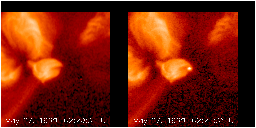The birth of an anemone, with flashes
Science Nugget: May 28, 1999
Introduction
This week's joint observations with TRACE, Tenerife et al. have been following
NOAA active region 8552. As we watched, an "anemone" active region was
born The term "anemone" is recent, stimulated by the appearance of a sea
anemone, much prized in the land of Yohkoh. Another term is "rosette."
Such active regions do not seem to want to connect beyond their boundaries
into the larger-scale corona, for reasons not yet fathomed. Of course,
one immediate thought is that an anemone may simply be and active region
born with the wrong helicity
for its environment (link is to a .ps file).
The observting program aims (it continues at time of writing) at characterizing
"moss," a very interesting subject indeed, so this anemone and its flasher
(see below) are extra bonuses.
The appearance of the anemone
As shown in the movie (click on the thumbnail below)

the anemone sprang into existence quite rapidly. Sorry to say, due to
technical problems, the first frame appears only on the thumbnail, not
the movie itself!
The flashing source
In the full-resolution movies of this anemone, which have a time resolution
of about 30 sec, a curious flashing source appeared. Not always in exactly
the same spot, but close; not always with exactly the same morphology,
but always compact and isolated; here is one appearance:

The source essentially is unresolved and appears in the interval between
the two frames shown. For those of you who remember, the resemblance to
Pacman is uncanny. We have seen flashing compact sources before, of course;
the likeliest interpretation would be persistent flux emergence in the
form of tiny bipoles. The beauty of this observation is that we have TRACE
and Tenerife both observing, and we can confirm this suggestion quite well.
The figure below shows the flickering time series obtained from a small
photometric box positioned at the source (click on image):

There seem to have been as many as 15-20 different flashes. Amazing!
Nomenclature
Apologies to non-specialists who have read this far. We try to avoid jargon,
but in fact the features seen on the Sun are so complicated (and also often
beautiful) that even hard-nosed observational scientists are inclined to
be poetic about names of things: "anemone", "moss", "flasher" etc. in this
science nugget alone. Trust us, these things really are showing us different
physics, and really do deserve their own names. "Flasher" may be a bit
overdone, though.
May 29, 1999: Hugh Hudson
(hudson@isass0.solar.isas.ac.jp)



